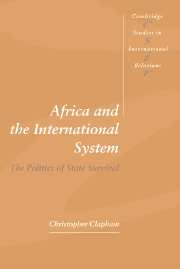Book contents
- Frontmatter
- Contents
- Acknowledgements
- List of acronyms and abbreviations
- Part I African states and global politics
- 1 Fragile states and the international system
- 2 The creation of an African international order
- 3 Domestic statehood and foreign policy
- Part II Patterns of alliance
- Part III Struggling with decay
- Notes
- Bibliography
- Index
- CAMBRIDGE STUDIES IN INTERNATIONAL RELATIONS 50
2 - The creation of an African international order
Published online by Cambridge University Press: 09 October 2009
- Frontmatter
- Contents
- Acknowledgements
- List of acronyms and abbreviations
- Part I African states and global politics
- 1 Fragile states and the international system
- 2 The creation of an African international order
- 3 Domestic statehood and foreign policy
- Part II Patterns of alliance
- Part III Struggling with decay
- Notes
- Bibliography
- Index
- CAMBRIDGE STUDIES IN INTERNATIONAL RELATIONS 50
Summary
People and government in Africa
In seeking to understand the international relations of Africa, it is helpful to start by looking at a map of the continent on which state boundaries do not appear, and which is coloured, not in a patchwork of blocks demarcating the formal territories of individual states, but in shades which correspond to population density and forms of economic activity, and to the patterns of altitude, rainfall and vegetation on which human life largely depends. What emerges is a continent which, despite rapid recent population growth, is still sparsely inhabited, with dense concentrations of people in relatively few places, including notably the West African coast and savannah, the Ethiopian highlands, the Great Lakes region of central Africa, and the central and southern highlands. These regions include large modern cities, founded for purposes of government (like Addis Ababa), mineral extraction (like Johannesburg), or foreign trade (like Lagos); but they still largely correspond to areas where local resources are sufficient to sustain relatively high populations, and which in turn have been able to maintain well-established structures of government.
Over much of the continent, both people and resources are thinly and precariously spread. Huge tracts of territory are suited only to animal husbandry, and require the people who inhabit them to move long distances with their flocks and herds to take advantage of seasonal conditions.
- Type
- Chapter
- Information
- Africa and the International SystemThe Politics of State Survival, pp. 28 - 43Publisher: Cambridge University PressPrint publication year: 1996



